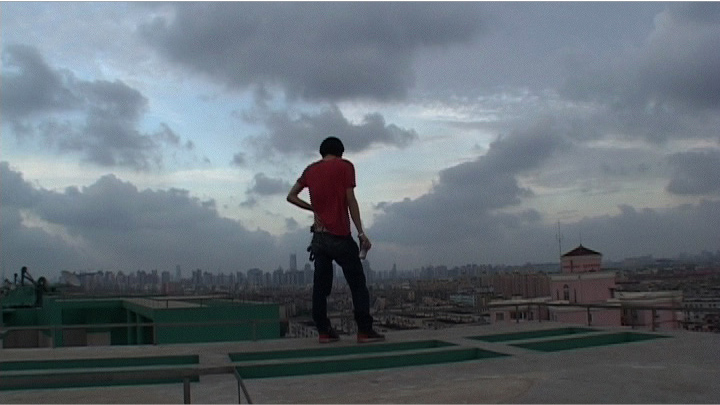Shows
“Walking On The Fade Out Lines”


“Walking On The Fade Out Lines” exhibited works from the collection of renowned Italian art patron Patrizia Sandretto Re Rebaudengo by 23 international contemporary artists around the theme of “the practice of Otherness,” as expounded in the wall texts and an elegant guidebook. However, the stylish presentation and use of anodyne phrases to frame the project—such as, “There is always a foreign land from where we stand,” from Rockbund Art Museum director Larys Frogier, as if the audience were in for a spot of alterity sightseeing—could not subdue the unrest expressed in many of the pieces.
Historical works from the early 1990s were reminders of bitter conflicts around spatial relations, such as the then-ongoing Yugoslav Wars. Mark Manders’s installation, Nocturnal City Scene (1993), features an asymmetrically shaped metal box, its weight supported by books of various thicknesses, used to keep the structure level. From another side, one views through a glass pane the blackened remains of what appears to be a temporary camp, suggested by an arrangement of household items including cups and forks.
Historical specificity was also notable in the earliest work in the show, Charles Ray’s 1986 installation, Viral Research. The ink that finds a common level between different shaped glass vessels references both the black substance used to print obituaries and the metaphorical darkness that pervaded communities hit by the AIDS epidemic, while the vessels embody people resilient to the disease that connects them.
Several works suggested individuals in situations over which they have no influence. In Damien Hirst’s Love Is Great (1994), dead butterflies are caught on a tacky expanse of azure household gloss. Speaking on the origin of the butterfly paintings, Hirst has remarked: “You paint the walls white, and then life comes in and fucks it up. Like minimal paintings that have been fucked up by butterflies landing in paint.” Yet, read in the context of this exhibition, Love is a tensioned abstraction created by pinning fugitive lives in new configurations. Have You Seen Me Before? (2008), Paola Pivi’s sculpture of a photogenic life-sized polar bear made “cute” by a coat of yellow feathers, and Donghee Koo’s video, Tragedy Competition (2004), in which actors compete for how long they can produce theatrical tears, feature similarly objectified subjects that have forfeited their agency under the abstruse control of someone else’s idea.

Shanghai itself is the subject of Song Tao’s video, From the Last Century (2006). In three scenarios, snatches of dialogue and first person voiceover tell of unsettled urban lives subject to unpredictable change. In one precarious episode, evoking meditation in sacred mountains combined with Parkour, a young man fulfills his ambition to scale the roofs of all the apartment blocks in his childhood compound. He clings to memory but the landscapes he overlooks are transformed by development.
Similarly, visitors might have enjoyed a sense of orientation, surveying the gallery below from a balcony on the fifth floor, but found the impression of omnipitence was challenged by a work split between both levels: Zhang Ruyi’s Decoration: Displacement (2018), the only new commission in the exhibition. The section on the lower floor is in two parts. At the entrance of the fourth floor gallery, a rudimentary concrete sink is fixed to the wall, complete with a bar of soap. In the opposite corner of the gallery, the walls are covered in white tiles, as might be found in a shower room. A drain is located high on one of these walls, and an apartment door, cast in concrete, is set into the wall at right angles, suggesting the simultaneous orientation of multiple spaces. With its grid and reference to ablution, the work indicates universals—purity, logic, and ritual cleansing.
On the upper floor, Zhang’s work continues with a mirror-lined alcove, the floor rising to provide access to a spy hole through which the city outside could be viewed. This distant reality is the converse of the artworks inside, the sometimes fantastical musings that they embody further amplified by the exhibition’s curatorial rhetoric of “infinite displacement,” “invincible movement,” “sensitive friction” and “dazzling interruption, […] so precious and indefinite.” The simple device of the spy hole reminds the spectator that the museum itself protects art from its “Other.”
The “lines” of the title encompassed a range of frontiers—separating body and mind, individual and collective, real and fictional. Many works focused on mechanisms of demarcation, understanding “Other” to be defined by exclusions. There was tension between this contextually relevant view and the curatorial argument, with its allusions to imminence and proximity, skirting the question of control and definition. At a time when different people encounter the porosity of real borders in radically different ways, the exhibition seemed reticent, secure in its tolerant internationalism, remote from the scars of the outside world.
“Walking On The Fade Out Lines” is on view at Rockbund Art Museum, Shanghai, until May 27, 2018.







